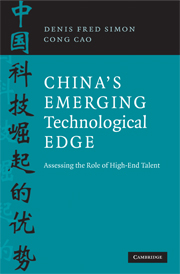Book contents
- Frontmatter
- Contents
- List of Figures and tables
- Acknowledgements
- Abbreviations
- Introduction
- 1 Human resources, technological innovation, and economic growth
- 2 China's talent challenge
- 3 Human resources in science and technology, and their structure and characteristics in China
- 4 Higher education and scientists and engineers in the pipeline
- 5 Utilization of scientists and engineers in China
- 6 “Brain drain,” “brain gain,” and “brain circulation”
- 7 Supply and demand of science and technology talent in China: key drivers
- 8 China's talent in key emerging technologies
- 9 Whither China's talent pool?
- Appendix: Understanding Chinese science and technology human resources statistics
- References
- Index
Appendix: Understanding Chinese science and technology human resources statistics
Published online by Cambridge University Press: 25 January 2011
- Frontmatter
- Contents
- List of Figures and tables
- Acknowledgements
- Abbreviations
- Introduction
- 1 Human resources, technological innovation, and economic growth
- 2 China's talent challenge
- 3 Human resources in science and technology, and their structure and characteristics in China
- 4 Higher education and scientists and engineers in the pipeline
- 5 Utilization of scientists and engineers in China
- 6 “Brain drain,” “brain gain,” and “brain circulation”
- 7 Supply and demand of science and technology talent in China: key drivers
- 8 China's talent in key emerging technologies
- 9 Whither China's talent pool?
- Appendix: Understanding Chinese science and technology human resources statistics
- References
- Index
Summary
Throughout this book, we have relied upon a vast array of statistics and related data concerning China's human resources in science and technology (HRST), as well as Chinese science and technology (S&T) and education activities. The bulk of our research has focused on the use of primary statistical data from Chinese government sources, mainly because there are not many, if any, alternative reliable sources of such data in this field and also because we wanted to develop a picture of the S&T human resources situation in China that is similar to the one used by Chinese policymakers and scholars. In relying heavily on these Chinese sources, we recognized from the start that there remains a huge gap between China and developed countries, especially Europe and the USA, in collecting and reporting statistics. A host of cautions was certainly warranted as we used these data, even after scrubbing for inconsistencies and associated problems. Indeed, as we have pointed out in various sections of the book, problems with these data raise some serious questions about the ability of Chinese policymakers to develop appropriate policies and incentives given their dependence on data that sometimes pose more questions than answers.
These issues and minefields acknowledged, however, we also believe it is just as important to recognize the tremendous progress that the People's Republic of China has made in developing a more uniform, coherent, and systematic series of statistics concerning domestic S&T activities and outcomes (Gao et al., 2007; Schaaper, 2004).
- Type
- Chapter
- Information
- China's Emerging Technological EdgeAssessing the Role of High-End Talent, pp. 347 - 375Publisher: Cambridge University PressPrint publication year: 2009



